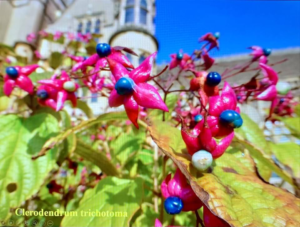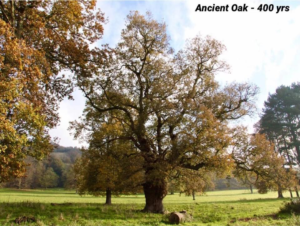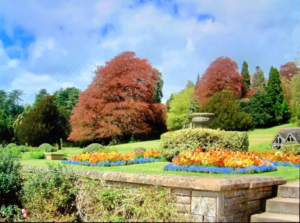 Chris started by telling us a bit about the history of the Tyntesfield Estate. The house was built for William Gibbs and completed in 1884. The estate was purchased by the National Trust in 2002.
Chris started by telling us a bit about the history of the Tyntesfield Estate. The house was built for William Gibbs and completed in 1884. The estate was purchased by the National Trust in 2002.
There are 37 labels from the original trees planted in the late 1800s. There is a huge selection of trees with beautiful foliage and flowers and look stunning when they are at their best. Some parts of the estate are the same as they were originally including some of the tree walks. A few of the trees in the laurel walk have been replaced by taking cuttings from the original trees. The holly walk is 140 years old and some of the hollies have also been replaced.
He told us about ancient, veteran and champion trees. They have an oak which is an ancient tree.  Ancient trees are very old one but vary in age depending on the species. However, all ancient trees are also veterans. Veteran trees can be any age, but show ancient characteristics. An example of a veteran tree is a beautiful sweet chestnut over 200 years old. There are also champion trees which are the largest of their species. The tallest tree on the estate is from the United States of America is 37 ½ meters tall. Some of the trees have been lost due to disease or damaged by animals and in 2018 due to the dry weather a number of trees were lost.
Ancient trees are very old one but vary in age depending on the species. However, all ancient trees are also veterans. Veteran trees can be any age, but show ancient characteristics. An example of a veteran tree is a beautiful sweet chestnut over 200 years old. There are also champion trees which are the largest of their species. The tallest tree on the estate is from the United States of America is 37 ½ meters tall. Some of the trees have been lost due to disease or damaged by animals and in 2018 due to the dry weather a number of trees were lost.
 We were shown the orangery in 1901 and then how very different it looks today. Between 2015 and 2019 they planted a new orchard with a huge variety of trees. We all enjoyed Chris’s talk and we were tempted by the Tyntesfied Tree Guide that can be purchased and used to identify trees on the estate. However, we were even more tempted by the offer of a guided walk when we can once again meet in groups after the corona virus pandemic.
We were shown the orangery in 1901 and then how very different it looks today. Between 2015 and 2019 they planted a new orchard with a huge variety of trees. We all enjoyed Chris’s talk and we were tempted by the Tyntesfied Tree Guide that can be purchased and used to identify trees on the estate. However, we were even more tempted by the offer of a guided walk when we can once again meet in groups after the corona virus pandemic.

